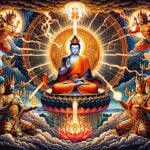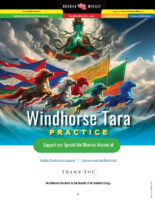Podcast 1, Spread the Dharma: Stumbling on the Buddha and the Eightfold Path — plus 5 other podcasts
- Listen and subscribe on Spotify>>
- Listen on our podcast host Buzzsprout>>
- Listen on our website Spread The Dharma>>
It should also be listed on (or appear shortly on):
- Apple Podcasts
- Google Podcasts
- Apple Music
- Stitcher
- iHeart Radio
- Pandora
- TuneIn+Alexa
- Podcast Addict
- Podchaser
- Pocket Casts
- Deezer
- Listen Notes
- Player FM
- Podcast Index.
Podcast 1: Stumbling on the Buddha — and the Eightfold Path
Host: Lee Kane, Editor, Buddha Weekly
All Episodes can be found organized together on the Spread The Dharma Podcast Website. Episodes should start indexing on your favorite Podcast Indexes — Apple Podcasts, Spotify, Google Podcasts and many others — shortly.
Transcript
Welcome to the Buddha Weekly Podcast, Spread the Dharma. Today’s topic, “Stumbling on the Buddha — and the Eightfold Path.”
Let’s start with a simple visualization. Imagine, a peaceful scene, in a pristine glade. Birds are singing. The air is lightly scented. You see deer grazing. Then, you look across the rolling landscape and see a very noble man, sitting cross legged on the ground, his back straight, his bearing regal, yet he wears simple robes. He is closely attended by five monks — who are listening intently with half-closed eyes.
As you stroll by, you feel something. A sense of peace. The man’s face is serene and beautiful. He almost appears to glow. His voice, though not loud, is heard even across the glade.
And, this captivating man, says something that makes you simply stop. And listen.
“What, monks, is the truth of suffering? Birth is suffering, decay, sickness and death are suffering. To be separated from what you like is suffering. To want something and not get it is suffering. In short, the human personality, liable as it is to clinging and attachment brings suffering.”
And you are mesmerized. You stumbled across this man in the glade with his five disciples, at a time in your life when your own suffering is intense. This man, whose voice is so quietly powerful, talks of “the middle way” and the “eightfold path” that relieves all suffering. And, suddenly, you are sitting on the grass, listening to this man they call the Buddha.
This moment, we stumbled upon, is the moment in history when the Buddha “Turned the Wheel of Truth” — better known as the Discourse That Sets Turning the Wheel of Dharma.
It’s not hard to imagine. I, myself — and many others I know — stumbled across the “Buddha” in this way. Not in Deer Park, literally, but reading that first teaching of the Buddha — it’s like you are there.
When I study sutra, or meditate and recite sutra, I try to visualize myself there. It’s a wonderful way to practice and absorb the teachings.
Today, we are talking about the very first teaching of Shakyamuni Buddha, who was born a prince, as Gautama. This teaching was in a setting much as I described, in Deer Park. This teaching concisely frames one of the essence teachings of Buddhism, known as the Eightfold Path. It is the first guidance from the sage of the Sakyas — a recipe on how to reduce, and ultimately to eliminate, the suffering of Samsara.
It is also sometimes wonderfully labeled the Path of Freedom. I like to think of it as the Eight Rights of the Buddha.
I am today’s host, Lee Kane, Editor of Buddha Weekly. The mission of Buddha Weekly is to “Spread the Dharma.” Since 2007 we’ve published thousands of articles at Buddha Weekly dot com. We now host a growing YouTube Channel with several videos each week.
Welcome, now, to the first podcast of Buddha Weekly — which we’ve named after our mission: Spread the Dharma.
This Noble Eightfold Path of the Buddha, the very map to the elimination of suffering — this wonderful first teaching at Deer Park — is the heart of Buddha’s teachings. His teachings were recorded by his followers in 80,000 texts, some long, some short, some simple, some so mind-bending they require a lifetime of contemplation, and others very practical. There’s even a sutra for political leaders. Another sutra for householders with advice on managing money. Then, the later teachings, which focused more on the Bodhisattva path, were expansive in their view — hence, the name Mahayana, or the Great Vehicle, with room enough aboard for all sentient beings. Before jumping that great vehicle, though, we usually start with the teachings of the noble elder path, which embraces three important things: sila, or morality, samadhi, or meditation, and prajna, or insight — also called wisdom.
But, what distinguishes His noble teachings — starting here, with the teachings on the Eightfold path — is its positive, affirmative nature. There are no “do nots”, don’t do this, don’t do that. The Noble Eightfold Path speaks in positive, warm terms.
In this sutra, Buddha taught the “cure” to the disease of suffering as eight positive, affirmative activities that can help us rise out of Samsara. Buddha did not establish cannots or laws, but instead coached us on what we can (and should) do. He taught by example and by inspiration — not by punishment and rules.
In other words, he did not teach “do not swear” or “do not lie.” — he suggested “right speech.” Buddha taught in much more affirmative terms. It might be easier, for example, to say “do not lie,” but Buddha instead taught us how to generate loving-kindness as the remedy for harsh speech. He didn’t prohibit — he coached.
Buddha’s teachings are universally inspiring. One famous metaphor sees the Buddha as the Doctor. In Buddhism, we are the sick patient — suffering as a result of our cravings and attachments and emotions — and the Doctor is the Buddha who shows us how to release those craving and attachments. The Medicine in this case is the Dharma, the teachings of the Buddha. Along the way, we are helped by the Sangha, the teachers and disciples of the Buddha, who are the front-line workers in our case.
The go-to medicine, in this case, is the Eightfold Path.
Noble Fourfold Path
Before giving the “prescription”, Buddha first taught the Four Noble Truths — so that we would understand the metaphorical “disease” we are treating. He said,
“The human personality, liable as it is to clinging and attachment brings suffering.”
The Four Noble Truths he presented are:
- Dukkha — that suffering is an innate characteristic of living in samsara, that arise from our sensory contacts.
- Samudaya — the origin of this suffering is our craving, desires and attachments, or, as Buddha said, “Birth is suffering, decay, sickness and death are suffering. To be separated from what you like is suffering. To want something and not get it is suffering.”
- Nirodha — that it is possible to eliminate this suffering by renouncing, or “letting go” of cravings, desires and attachments.
- Magga — which is the Eightfold Path leading to the release of all suffering.
Not a Step-by-Step Teaching: Simultaneous Rights
So what are the Eight Rights? This — cure. By helping to de-condition ourselves from years of sensory inputs, habit and cravings, we can gradually limit and reprogram them from “pain points” to insights.
“Right” might be the wrong word; its an indelicate translation. At the first teaching at Deerpark, Shakyamuni Buddha said to his monks:
“This is the noble eightfold way, namely, right understanding, right intention, right speech, right action, right livelihood, right attention, right concentration, and right meditation.”
The word “right” (sometimes translated as “correct”) It doesn’t imply there are also eight “wrongs.” There are no “thou shalt nots” in Buddhist teachings. There are no punishments — other than our own self-impose on ourselves, the unavoidable workings of personal karmas.
As with all Buddhist teachings, we are asked to consider, contemplate and live the teachings. We are not asked to take anything on faith — it’s about self-discovery of the truth of the Buddha’s teachings. We can work first on conduct — speech, action, livelihood. Maybe we can’t work on “livelihood” right now, because we need our jobs. We have to survive. Over time, though, we try to renounce the baggage of our past conditioning, by disciplining ourselves through better-and-better-and better conduct.
There is no need to renounce living. We don’t need to run off to a nunnery or monastery. The eight rights are helpful in daily, lay living. We can still raise our children, go to work, go to the movies, play hockey, live our lives. The key thing is — as Buddha clarifies in future sutras on concentration and insights — to be mindful at all times of everything we do. We might engage in speech that hurts another person — before we can stop ourselves. But, we regret it. We start deprogramming ourselves, starting with an apology and a little more mindfulness. Next time it happens, we might catch ourselves at the “intent” stage, before we open our big mouth. Buddha’s way is always the middle way, step-by-step. Buddha taught the truths that he had learned himself throughout many lifetimes — as indicated in the lovely Jataka Tales — and certainly many years of his live as Prince Gautama.
Just as a quick overview, here is a tight synopsis of the eight “rights” — necessarily incomplete, but containing the gist.
In summary those are:
- Right Understanding
- Right Intent
- Right Speech
- Right Action
- Right Livelihood
- Right Effort
- Right Mindfulness
- Right Concentration.
- Can it be that simple? Yes — it really can be that simple.
- Right Understanding
Right Understanding
Right Understanding is clear knowledge of the Four Noble Truths, encompassing the “Three Basic Facts of Existence”. What are the Three Basic Facts of Existence?
As Buddha taught: Aniccha, which translates as Impermanence; Anatta, which is Pali for “non self”; and Dukkha , translated as suffering or unsatisfactoriness. These are big topics, and we look to the Dharma teachings and commentaries, and our own teachers — plus, our own insight meditations — for guidance on “right understanding.”
Right Thoughts — or Clear Thinking.
The next one is Right thoughts or clear thinking. With clear knowledge, clear thinking follows suit. This is known as initial application of knowledge.
Thoughts mould a person’s nature and direct their course and direction of action. Unwholesome thoughts will debase and erode a person’s character over time, while wholesome thoughts will lift him higher and higher.
In particular, Right Thoughts are:
- Renunciation (Nekkhamma) of worldly pleasures, and selflessness (altruism). This is “medicine” for insatiable desires and selfishness.
- Loving-kindness, also knwon as Metta or good will towards people, including yourself; which is the medicine for hatred, ill-will, aversion, dislike, detest and spite.
- Harmlessness (Avihimsa) or compassion, which is our medicine for cruelty and callousness.
Right Speech — Expressing the Right Thoughts
This may seem self-evident, but if it was so easy, would there be so much slander, insults, harshness, hate speech in the world. And, lets face it, gossip is not harmless either.
The medicine for here is to generate that harmless, peaceful mind we started cultivating with right thoughts.
Again, mindfulness — which as most people know, is a central practice in Buddhism — takes a central role here. We may not be able to “cease” our harmful internal mental gossip, chatter and hate, but with mindfulness we can subdue the negative thoughts, and eliminate the harmful speaking.
Right Action — Buddhist Karma Front and Centre
Karma isn’t really a Buddhist concept — it’s a core truth transcending any one spiritual path — but Buddhism embraces the core truth of Karma. Karma simply means activity and their repercussions — which includes our thoughts, speech and actions.
So, in this peaceful Deer Park, Buddha taught his five close disciples about the three unwholesome deeds. He advised abstinence and reduction of negative karma activities, such as killing, stealing, sexual misconduct. By sexual misconduct, he didn’t mean personal sexual preferences — he was referring to specifically to deception, abuse and molestation.
Right Livelihood
If you feel good about your job, it’s probably right livelihood. Do you help people? As long as you harm no one — and that would include the environment, since that impacts all beings — then it’s right livelihood.
Buddha wouldn’t put things in a negative context, but it should be obvious that any attempt at purifying thoughts, words and actions would be severely hindered by five kinds of trade that clearly are NOT right livelihood as indicated in commentaries. Those are:
- Weapons (arms) production,
- Human slavery,
- Any occupation involving killing,
- Producing anything known to be bad for sentient beings,
- Poisons: producing poisons, pollution and other harmful substances.
Right Effort
To do anything in life requires determination, persistence and energy. The sustained, lifelong practice of the Noble Eightfold Path is the very definition of Right Effort. Right Effort includes developing good habits, such as practicing right mindfulness, right meditation and other positive moral acts in your daily life — not just occasionally, but as often as you can. No one is perfect, we correct as we go, developing new habits that reinforce Right Effort.
Right Mindfulness
Mindfulness is the secret medicine in Buddha’s prescription. By remaining mindful in all moments, we can refrain from negativing thinking and actions. We can be aware of our cravings and attachments. What is it, exactly? Mindfulness is the constant watching or self-observation of your own body and actions, feelings, thoughts. We’ll talk more about this critical method in future podcasts, especially the various types of mindfulness.
Mindfulness shouldn’t be confused with contemplation, analysis and analytical meditation. It’s different. We don’t think ahead or analyze in mindfulness — we retain full, present awareness.
That’s not to say concentration and analysis aren’t important. Which leads us to the last of the Eight Rights: Right Meditation.
Right Meditation
Simply put, Right Meditation is deep concentration or total focus. The purpose is to train your mind to obey you and not the other way round. Instead of the habits and cravings being in charge, you train your mind to take the reins. This practice is nuts and bolts in Buddhism, from Samatha to Vipassana to Prajna meditation — don’t worry I’ll cover those in future podcasts. There are also visualization meditations, such as the advanced methods in Vajrayana.
Over the course of the next forty plus years of Buddha’s life, he taught, as recorded in various discourses. He taught more-and-more advanced methods. He expounded on the Eight Rights many times. He talked to daily living. He even taught kings and politicians.
The important thing to realize with Buddha’s discourses is that he taught us to self-help ourselves. He was the original self-help guru. He didn’t miraculously snap his fingers and take away our pain. He taught us how to do it for ourselves. This is why of the Three Jewels — the Buddha, the Dharma and the Sangha, translated as the “Teacher” the “Teachings” and the “Followers” — of those, it is the Dharma jewel, the teachings, which are the most important. Contained in those teachings are proven methods to help ourselves. Regardless of our suffering, Buddha showed us how to overcome it.
Now, that we’ve virtually met the Buddha in Deer Park, I hope you’ll return for our next visit with the Enlightened One, in the second podcast of “Spread the Dharma.”
I’m Lee Kane, editor of Buddha Weekly, and thank you for joining me.
We hope you enjoyed our first podcast of Spread the Dharma, Stumbling on the Buddha.. Please join us next time for a deep dive into Amitabha, the Buddha of Infiniate Light.
More Episodes (Multip Player)
More articles by this author
Search
Latest Features
Please support the "Spread the Dharma" mission as one of our heroic Dharma Supporting Members, or with a one-time donation.
Please Help Support the “Spread the Dharma” Mission!

Be a part of the noble mission as a supporting member or a patron, or a volunteer contributor of content.
The power of Dharma to help sentient beings, in part, lies in ensuring access to Buddha’s precious Dharma — the mission of Buddha Weekly. We can’t do it without you!
A non-profit association since 2007, Buddha Weekly published many feature articles, videos, and, podcasts. Please consider supporting the mission to preserve and “Spread the Dharma." Your support as either a patron or a supporting member helps defray the high costs of producing quality Dharma content. Thank you! Learn more here, or become one of our super karma heroes on Patreon.
Lee Kane
Author | Buddha Weekly
Lee Kane is the editor of Buddha Weekly, since 2007. His main focuses as a writer are mindfulness techniques, meditation, Dharma and Sutra commentaries, Buddhist practices, international perspectives and traditions, Vajrayana, Mahayana, Zen. He also covers various events.
Lee also contributes as a writer to various other online magazines and blogs.














